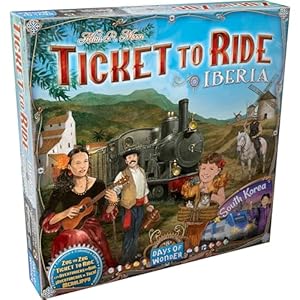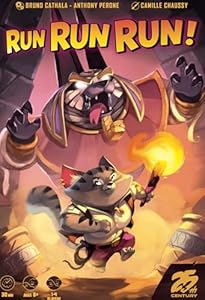Ticket to Ride: South Korea – K. David Ladage
One of the beautiful aspects of Ticket to Ride is the versatility of the core rules. Adding elements for new maps is a breeze! They have added tunnels and stations (Europe), stocks (Pennsylvania), passengers (Germany), a tech tree (United Kingdom), and exploitable resources (Heart of Africa). The game has been reimagined for smaller player counts and table footprint (New York, London, etc.), there is a print-and-play version that was created for the COVID crisis (Stay at Home), and they recently added a Legacy Campaign version to the series.. Every time they create a new map/expansion for the game, my friends and I are excited all over again to see what is coming next.
South Korea has a map where the track colors are grouped into districts. There is a district board where players are competing for up to ten points in each of the eight districts. In addition, you have three cards that allow you to add a one-time bonus of +1, +2, and +3 to an action: you can draw +1, +2, or +3 more cards (train cards or tickets) on your turn, you can gain +1, +2, or +3 more status in a district with your play, and so on. Both of these add some interesting twists to the calculus for each turn: playing on the district board costs you a train that cannot be used to complete a route. Overall, we had a great time with this one! Will definitely play again (after we flip the board and try out Iberia).
Ease of entry?:
★★★★★ – No sweat
Would I play it again?:
★★★★★ – Will definitely play it again
Read more articles from K. David Ladage.
Men-Nefer – David McMillan
Recently, I had the pleasure of playing Men-Nefer for the first time. Men-Nefer takes place in Ancient Egypt. Over the course of the game, players will be taking actions to prepare mummies for burial, construct the pyramids, make pilgrimages to the temple, ply the river Nile for trade, build obelisks, and erect sphinxes. It’s a worker placement game where action spaces are shared, but the longer you wait to take an action, the more expensive it may become to do so. Rounds are broken down into nine actions each: playing out your three workers into the action rows to perform the actions of the three tiles you begin the round with; claiming three new tiles to replace the ones you’ve used (for use in the next round); and sliding your workers from one column of their action row into the other to perform the action associated with the row.
The game flowed pretty smoothly and it didn’t take long for me to get into the groove, although there was one rule that I was struggling to internalize. That was totally a ME thing, though and not an issue with the game itself. While I enjoyed the game and would be willing to sit down and play it again if someone were to suggest it, this isn’t one that I feel any compulsion to add to my own collection any time soon.
Ease of entry?:
★★★★★ – No sweat
Would I play it again?:
★★★★☆ – Would like to play it again
Read more articles from David McMillan.
Run Run Run (Second Edition) – Andy Matthews
It’s hard to believe that 25th Century Games is able to produce as many games as they do with such a small staff. But their roster is lengthy and worthy of note. Over the past two months they’ve sent along 5 games, and that’s only a part of what they’ve released this year. They’re not all bangers, but the quality and care put into their games is evident in the production value and graphic design.
My most recent play was Run Run Run (Second Edition); the US release of a Bruno Cathala game. Run Run Run is a cooperative game in which players are “catventurers” exploring the depths of a mummy’s tomb. Their goal is to defeat all the normal mummy’s, then awaken the boss mummy and defeat him as well. This is a tile-laying and exploration game which has players placing tiles in specific arrangements to unlock the mummy’s tomb, as well as gather torches and treasure. There’s also dice involved: movement for the mummies and attack for players.
There’s a lot going on here, for what I’d consider a kid/family game. Tile laying, unlocking rooms, dice rolling, torch collecting, health point management, etc. Gameplay was a bit rough because we had to keep referring back to the rules until we figured out what various icons meant. Making sure you keep your stock of torches up, and take out mummies as soon as they spawn, and you should be okay. But that boss mummy is no joke. If you’ve got older elementary or middle school kids, then you’re golden.
Ease of entry?:
★★★★☆ – The odd bump or two
Would I play it again?:
★★★☆☆ – Wouldn’t suggest it, but would happily play it
Read more articles from Andy Matthews.
Tapas – Tom Franklin
The central board is a 4×4 series of squares, with four additional squares along the edges. Those edge squares are filled with alternating tiles, one of yours, one of your opponent’s, etc. On a turn, you take one of your tiles and push an opponent’s piece into the center of the board.
Each piece has 1-4 ‘items’ on them. (One player has chili peppers; the other has what looks like baguettes. I’m not sure where the Tapas are.) The distance you push a tile into the board depends on the number of ‘items’ on your tile. The catch, of course, is that you score points by pushing your opponents tiles off the edge of the board. This means you don’t want your 3 and 4 ‘item’ tiles out there too early.
Over the two games we played, our scores were almost identical, and that’s my biggest issue with Tapas. Unless someone makes a serious mistake, your scores will remain all-but identical. This means playing two games and combining the scores won’t make much of a difference. Trust me, this is one sampling of Tapas you’ll want to skip.
Ease of entry?:
★★★★☆ – The odd bump or two
Would I play it again?:
★☆☆☆☆ – Would play again but will cry about it
Read more articles from Tom Franklin.
Fibonachos – Andrew Lynch
In a market as flooded as this one, a trick-taking game is only as good as its gameplay innovations. The central innovation to Fibonachos is that, instead of a trump suit, there are trump values. Any trick with two or more cards with values found in the Fibonacci sequence can only be won by a Fibonacci number. In theory, that should turn the calculus of leading on its head. You’re no longer safe leading with the highest card in a suit. In application, for reasons I can’t entirely figure out, the resulting game falls flat.
It may be that Fibonachos attempts to pack too many things into one package. In addition to the trump gimmick, each trick is worth a random number of points as determined by a separate deck of cards, and players who end up with a number of points equal to any given value within the Fibonacci sequence instead score the next value in the sequence. It is entirely possible that Fibonachos would be a better game if it married that trump trick to a simple bid-to-win trick-taker. As it is, there’s simultaneously too much and not enough going on, a nightmare pocket for a game to inhabit.
Ease of entry?:
★★★★★ – No sweat
Would I play it again?:
★★☆☆☆ – Would play again but would rather play something else
Read more articles from Andrew Lynch.














